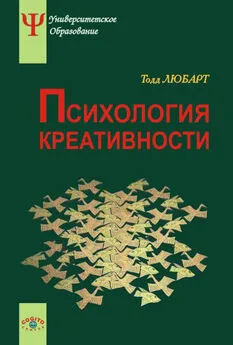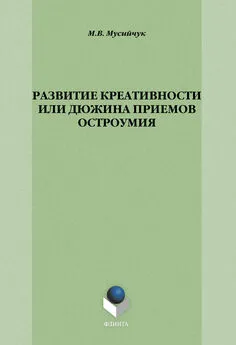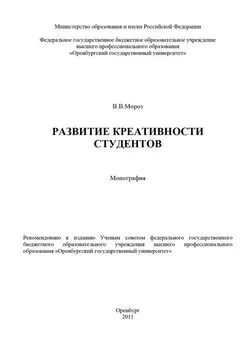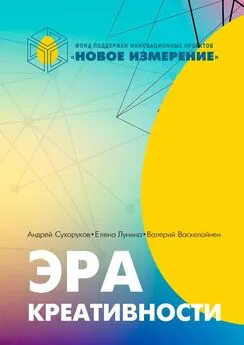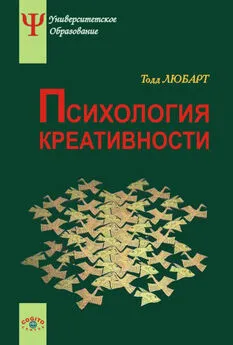Ф. Зенасни - Психология креативности
- Название:Психология креативности
- Автор:
- Жанр:
- Издательство:Литагент «Когито-Центр»881f530e-013a-102c-99a2-0288a49f2f10
- Год:2009
- Город:Москва
- ISBN:978-5-89353-221-0, 2-200-26284-1
- Рейтинг:
- Избранное:Добавить в избранное
-
Отзывы:
-
Ваша оценка:
Ф. Зенасни - Психология креативности краткое содержание
В учебном пособии, написанном коллективом авторов под руководством Тодда Аюбарта, дано систематическое изложение теоретических и практических вопросов креативности, или творческого мышления человека. Книга содержит сводку современных представлений о креативности, о творческом процессе и его развитии у детей и взрослых, о связи творческой способности с уровнем интеллекта, с личностными и эмоционально-волевыми качествами человека, а также с психопатологией. Значительное место посвящено проблеме измерения креативности. Подробно изложена модель эмоционального резонанса, выдвинутая Т. Аюбартом для объяснения механизмов влияния позитивных и негативных эмоций на креативное мышление.
Книга будет полезна студентам-психологам при изучении темы «Мышление» по курсу «Общая психология», а также как справочное пособие для всех, кого интересуют проблемы творчества.
Психология креативности - читать онлайн бесплатно ознакомительный отрывок
Интервал:
Закладка:
Hirt, E. R., Levine, G. M., McDonald, H. E., Melton, R. J., & Martin, L. L. (1997), «The role of mood in quantitative and qualitative aspects of performance: Single or multiple mechanisms?», Journal of Experimental Social Psychology, 33(6), 602–629.
Ho, D. Y. F., & Lee, L. Y. (1974), «Authoritarianism and attitude toward filial piety in Chinese teachers», Journal of Social Psychology, 97, 305–306.
Hocevar, D. (1976), «Dimensionality of creativity», Psychological Reports, 39, 869–870.
Hocevar, D., & Bachelor, P. (1989), «A taxonomy and critique of measurement used in the study of creativity», in J. A. Glover, R. R. Ronning & C. R. Reynolds (Eds.), Handbook of creativity (p. 53–76), New York, Plenum.
Hood, R.W. (1973), «Rater originality and the interpersonal assessment of levels of originality», Sociometry, 36, 80–88.
Hull, D. L., Tessner, P. D., & Di amond, A. M. (1978), «Planck's principle: Do younger scientists accept new scientific ideas with greater alacrity than older scientists?» Science, 202, 717–723.
Huteau, M. (1985), Les conceptions cognitives de la personnalite, Paris, PUF.
Huteau, M. (1987), Style cognitif et personnalite, Lille, Presses Universitaires de Lille.
Isaksen, S. G., & Parnes, S. J. (1985), «Curriculum planning for creative thinking and problem solving», Journal of Creative Behavior, 19(1), 1–29.
Isaksen, S.G., Lauer, K.J., Ekva ll, G., & Britz, A. (2000–2001), «Perceptions of the best and worst climates for creativity: Preliminary validation evidence for the situational outlook questionnaire», Creativity Research Journal, 13(2), 171–184.
Isaksen, S.G. & Treff inger, D.J. (1985), Creative problem solving: The basic course, Buffalo (NY), Bearly Limited.
Isen, A. M. (1999), «On the relationship between affect and creative problem solving», in S.W. Russ (ed.) Affect, creative experience, and psychological adjustment, p. 3–18, Philadelphia (PA), Brunner Mazel.
Isen, A. M., Daubman, K. A., & Nowicki, G. P. (1987), «Positive affect facilitates creative problem solving», Journal of Personality and Social Psychology, 52(6), 1122–1131.
Jamison, K. R. (1993), Touched with fire: Manic-depressive illness and the artistic temperament, New York, Free Press.
Jay, E.S., & Perkins, D.N. (1997), «Problem finding: The search for mechanism», in M.A. Runco (ed.), The creativity research handbook (Vol. 1, p. 257–293). Cresskill, NJ: Hampton.
Jeannot, A. (1986), Honore de Balzac: leforcat de la gloire, Paris, Ciba-Geigy, Editions Printel.
Johnson-Laird, P.N. (1988), «Freedom and constraint in creativity», in R.J. Sternberg (ed.), The nature of creativity (p. 202–219), New York, Cambridge University Press.
Kant, I. (1790/1888), The philosophy of Kant, as contained in Extracts from his own writings (selected and translated by J. Watson), Glasgow, Maclehose & Jackson.
Kaufmann, G. (1995), «A theory of cognitive strategy preferences in problem solving», in G. Kaufmann & T. Helstrup & K. H. Teigen (eds.), Problem solving and cognitive processes: A festschrift in honour of Kjell Raaheim (p. 45–76), Fagbokforlaget, Bergen/Sandviken.
Kaufmann & T. Helstrup & K. H. Teigen (eds.), (1997, August), «The mood and creativity puzzle», Paper presented at the American Psychological Association Convention.
Kaufmann, G., & Vosburg, S. K. (1997), «“Paradoxical” mood effects on creative problem-solving», Cognition and Emotion, 11(2), 151–170.
Kaufman, J. C. & Baer J. (2002), «Could Steven Spielberg manage the yankees? Creative thinking in different domains», The Korean Journal of Thinking and Problem Solving, 12(2), 5–14.
Kay, S. (1991), «The figural problem solving and problem finding of professional and semi professional artists and non artists», Creativity Reseach Journal, 4, 233–252.
Keefe, J. A., & Magaro, P. A. (1980), «Creativity and schizophrenia: An equivalence of cognitive processing», Journal of Abnormal Psychology, 89, 390–398.
Kim, S. H. (1990), Essence of creativity: A guide to tackling difficult problems, London, Oxford University Press.
Kipling, R. (1937/1985), «Working tools», in B. Ghiselin (ed.), The creative process: A symposium (p. 161–163), Berkeley, University of California Press.
Kirton, M. J. (ed). (1994), Adaptors and innovators: Styles of creativity and problem solving (revised ed.), London, Routledge.
Klein, R. L. (1972), «Age, sex, and task difficulty as predictors of social conformity», Journal of Gerontology, 27(2), 229–236.
Koestler, A. (1964), The act of creation, New York, Macmillan.
Kogan, N., & Pankove, E. (1972), «Creative ability over a five-year span», Child Development, 43(2), 427–442.
Koifman, R. (1998), The relationship between IQ, EQ and creativity, unpublished manuscript, Winsdor.
Krippner, S. (1967), «The 10 commandments that block creativity», Gifted Child Quarterly, 11(3), 144–156.
Kris, E. (1952), Psychoanalytic exploration in art, New York, International Universities Press.
Kubie, L. S. (1958), The neurotic distortion of the creative process, Lawrence, University of Kansas Press.
Kuhn, T. S. (1962), The Structure of Scientific Revolutions, Chicago, University of Chicago Press.
Langley, P., Simon, H., Bradshaw, G. L., & Zytkow, J. M. (1987), Scientific discovery: Computational explorations of the creative process, Cambridge, MIT Press.
Lautrey, J. (1980), Classe sociale, milieu familial, intelligence, Paris, PUF.
Lautrey, J., Bideaud, J., & Pierre-Puysegur, M. A. (1986), «Aspects genetiques et differentiels du fonctionnement cognitif lors de taches de sedation», L'Annee Psychologique, 86, 489–526.
Lautrey, J., & Ribeaupierre, A. de (2004), «Psychology of human intelligence in France and french-speaking Switzerland», in R. J. Sternberg (ed.), International handbook of the psychology of human intelligence, Cambridge, Cambridge University Press.
Lehman, H. C. (1953), Age and achievement, Princeton, NJ, Princeton University Press.
Li, J. (1997), «Creativity in horizontal and vertical domains», Creativity Research Journal, 10(2–3), 107–132.
Lubart, T. I. (1994), «Creativity», in R. J. Sternberg (ed.), Thinking and problem solving (p. 289–332), New York, Academic Press.
Lubart, T. I. (1999a), «Componential models», in M. A. Runco & S. R. Pritsker (eds.), Encyclopaedia of Creativity (Vol. 1, p. 295–300), New York, Academic Press.
Lubart, T. I. (1999b) «Creativity across cultures», in R. J. Sternberg (ed.), Handbook of creativity (p. 339–350), Cambridge, Cambridge University Press.
Lubart, T. I. (2000–2001), «Models of the creative process: Past, present and future», Creativity Research Journal, 13(3–4), 295–308.
Lubart, T. I. (2003), «In search of creative Intelligence», in R. J. Sternberg, J. Lautrey, & T. I. Lubart (eds.), Models of intelligence: International prospectives (p. 279–292). Washington DC, American Psychological Association.
Lubart, T. I., & Getz, I. (1997), «Emotion, metaphor, and the creative process», Creativity Research Journal, 10, 285–301.
Lubart, T. I. (1998), «The influence of heuristics on psychological science: A case study of research on creativity», Journal for the Theory of Social Behaviour, 28(4), 435–457.
Lubart, T. L, & Lautrey, J. (1996), «Development of creativity in 9– to 10-year old children», Paper presented at the Growing Mind Congress, Geneve, Suisse.
Lubart, T. L, & Lautrey, J. (1998). «Family environment and creativity», Paper presented at the XV Biennal Meetings of the International Society for the Study of Behavioral Development, Berne, Suisse.
Lubart, T. I., Jacquet, A.-Y. & Pacteau, C. (2000), «Art des enfants, enfance de Part?», La Recherche, Hors serie № 4, 94–97.
Lubart, T. L, & Sternberg, R. J. (1995), «An investment approach to creativity: Theory and data», in S. M. Smith, T. B. Ward & R. A. Finke (eds.), The creative cognition approach (p. 271–302), Cambridge (MA), MIT Press.
Ludwig, A. M. (1992), «Culture and creativity», American Journal of Psychotherapy, 46(3), 454–469.
MacKinnon, D. W. (1962), «The nature and nurture of creative talent», American Psychologist, 17, 484–495.
Mackworth, N. H. (1965), «Originality», American Psychologist, 20(1), 51–66.
Maduro, R. (1976), Artistic creativity in a Brahmin painter community, Berkeley (CA), Center for South and Southeast Asia Studies, University of California.
Magnusson, D., & Backteman, G. (1978), «Longitudinal stability of person characteristics: Intelligence and creativity», Applied Psychological Measurement, 2(4), 481–490.
Mar'i, S. K., & Karayanni, M. (1983), «Creativity in Arab culture: Two decades of research», Journal of Creative Behavior, 16(4), 227–238.
Martin, L. L., Ward, D. W., Achee, J. W., & Wyer, R. S. (1993), «Mood as input: People have to interpret the motivational implications of their moods», Journal of Personality and Social Psychology, 64(3), 317–326.
Martinsen, O., & Kaufmann, G. (1999), «Cognitive style and creativity», in M. A. Runco & S. R. Pritsker (eds.), Encyclopaedia of Creativity (Vol. 1, p. 273–282). New York, Academic Press.
Maslow, A. (1968), Toward a Psychology of Being, New York, Van Nostrand.
Maurois, A. (1965), Promethee ou la vie de Balzac, Paris, Hachette.
Mayer, J. D., Salovey, P., & Caruso, D. (2000), «Models of emotional intelligence», in R. J. Sternberg (ed.), Handbook of intelligence (p. 396–420). New York, Cambridge University Press.
McClelland, D.C. (1962) «On the psychodynamics of creative physical scientists», in H. E. Gruber, G. Terrell & M. Wertheimer (eds.) Contemporary approaches to creative thinking (p. 141–174), New York, Atherton Press.
McCrae, R. R. (1987). «Creativity, divergent thinking, and openness to experience», Journal of Personality and Social Psychology, 52, 1258–1265.
McCrae, R. R., & Costa, P. T. (1987). «Validation of the five-factor model of personality across instruments and observers», Journal of Personality and Social Psychology, 52(1), 81–90.
McGraw, K. O. (1978), «The detrimental effects of reward on performance: A literature review and a prediction model», in M.R. Lepper & D. Greene (eds.), The Hidden Costs of Reward, Hillsdale (NJ), Lawrence Erlbaum Associates.
McLeish, J. A. B. (1976), The ulyssean adult: Creativity in the middle and later years, New York, McGraw-Hill Reyerson.
Mednick, S. A. (1962), «The associative basis of the creative process», Psychological Review, 69, 220–232.
Michael, W. B. (1999), «Guilford's view», in M.A. Runco & S.R. Pritzker (eds.), Encyclopaedia of creativity (vol. 1, p. 785–797). San Diego (CA), Academic.
Milgram, R.M., & Hong, E. (1999), «Creative out-of-school activities in intellectually gifted adolescents as predictors of their life accomplishment in young adults: A longitudinal study», Creativity Research Journal, 12 (2), 77–87.
Morris, W. N. (1992), «A functional analysis of the role of mood in affective systems», in M.S. Clark (Ed.), Emotion (p. 256–293). Newbury Park (CA), Sage.
Mouchiroud, C, & Lubart, T. I. (2001), «Children's original thinking: An empirical examination of alternative measures derived from divergent thinking tasks», Journal of Genetic Psychology, 162(4), 382–401.
Mouchiroud, C, & Lubart, T. I. (2002), «Social creativity: A cross-sectional study of 6– to 11-year-old children», International Journal of Behavioral Development, 26 (1), 60–69.
Mouchiroud, C, & Lubart, T. I. (2003), «Differences intra-individuelles dans le processus de generation d'idees originales chez l'enfant», in A. Vom Hofe, H. Charvin, J. Bernaud, D. Guedon (eds.), Psychologie differentielle: recherches et reflexions, Rennes, Presses Universitaires de Rennes.
Читать дальшеИнтервал:
Закладка:
